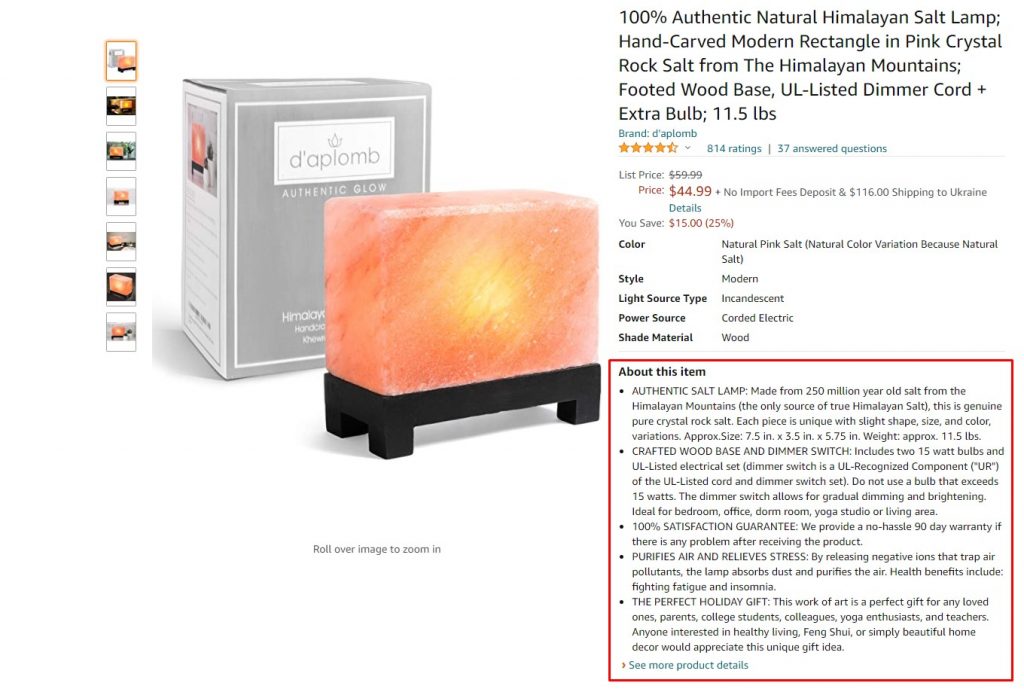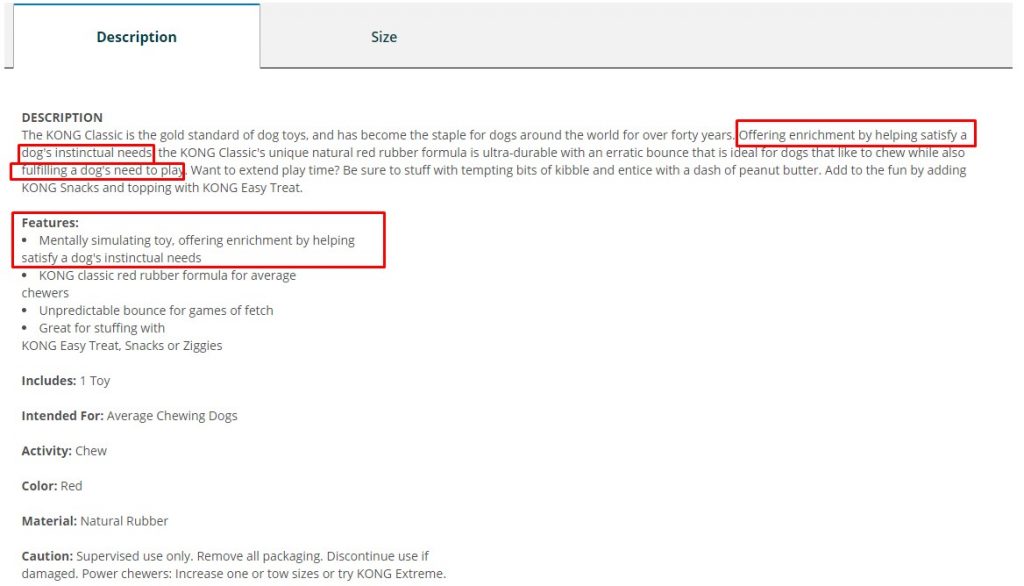How to Write SEO-Friendly Product Descriptions That Boost Sales
8 February 2021 Leave a comment ALL-HANDS SEO
Product descriptions are like salespeople. The good ones can persuade the buyer to purchase from you, while the bad ones only push them away. According to Salsify’s study, 87% of online shoppers admit product content impacts their purchase decision, and 50% have returned an item they bought because it didn’t match its description. That’s why having meaningful and precise product descriptions is so crucial.
However, it isn’t enough.
You may have the most persuasive and accurate product descriptions ever, but if nobody visits your product pages, they won’t matter. That’s why while focusing on the persuasiveness and accuracy of your product content, you should never forget about SEO.
In this blog post, we will show you how to write SEO-friendly product descriptions that drive traffic, impact the consumer’s mind, and boost sales. We prepared a list of valuable tips that will help you take your product content to the next level and persuade the buyer to click that “add to cart” button.
#1 Define your buyer persona
You should agree that it’s hard to convince anybody to purchase a product when you don’t know who you’re convincing. That’s why knowing your buyer persona is a must for writing a persuasive product description.
Ask yourself:
- What’s the age of your buyer?
- What’s their gender?
- What’s their annual income?
- How can your product help a person you are selling it to?
- What features and benefits of the product would interest this person the most?
- What language is the most appropriate for communicating with this person?
Answering these questions will help you understand who your buyer is and make your product description address this particular person.
Take a look at this example:
Who is the buyer persona of a Himalayan salt lamp? It’s definitely not just a guy shopping for a functional lamp for his home or office. Instead, the buyer persona is most likely someone interested in natural home remedies, unconventional products, or unique gift ideas.
The seller knows that and addresses their description to the buyer persona. Instead of focusing on the functionality of the lamp or its usability, the seller provides information that would most likely appeal to their potential customer.
Note the words the seller uses:
- Made from 250 million-year-old salt from the Himalayan Mountains (the only source of true Himalayan Salt), this is genuine pure crystal rock salt.
- By releasing negative ions that trap air pollutants, the lamp absorbs dust and purifies the air. Health benefits include: fighting fatigue and insomnia.
- Anyone interested in healthy living, Feng Shui, or simply beautiful home decor would appreciate this unique gift idea.
- The Perfect Holiday Gift: This work of art is a perfect gift for any loved ones, parents, college students, colleagues, yoga enthusiasts, and teachers.
The description of this Himalayan salt lamp is precise, clear, and persuasive. No wonder this product has been sold multiple times and has 814 reviews, most of which are positive.
If you want the same results, get to know your audience and make your product content appealing to their interest. However, it’s easier said than done. Sometimes it’s hard to tell what may interest the potential customer in your product, and that’s when keyword research comes in handy.
#2 Find what interests the buyer in your product
Let’s get back to the Himalayan salt lamp example. Suppose there is no description and you have to write it from scratch.
To get ideas, you can perform keyword research and find some related keywords on Google. Just type “Himalayan salt lamp” into the search field and scroll the page down. The search engine will provide you with eight keywords.
These keywords represent search queries that people interested in “Himalayan salt lamp” are also using. They can help you discover what interests the buyer in this particular product.
As you can see, people are curious about the benefits of Himalayan salt lamps, their side effects, prices, precautionary measures in using them, and other information. You can mention all of this in your description so that it answers a buyer’s question. That way, you’ll make your content informative and ensure that the potential customer won’t leave your website to look for info on other sites.
What’s more important, by including these keywords, you’ll increase your website traffic. People who will search for one of these related terms may find your website in search results, visit it, and buy the product after satisfying their curiosity. That way, you’ll kill two birds with one stone: make more sales and increase your website visibility in search results.
However, eight related keywords may not be enough for some products. That’s why we always recommend our readers using advanced SEO tools like RankActive’s Keyword Finder. This tool will help you find hundreds of related keywords for any search term in a few seconds. All you have to do is type your primary keyword in the corresponding field. After that, the tool will provide you with numerous results.
You can also visit other sections of the tool (Keyword Suggestions and Similar Keywords) to find even more terms to include in your copy.
While finding keywords is pretty easy, it may be challenging to choose the most appropriate terms and use them naturally in your product descriptions. That’s exactly what we’re going to help you with in the following paragraphs.
#3 Choose the right keywords and use them naturally
So you found a few hundred keyword ideas for the “Himalayan salt lamp” term. It’s obvious that you shouldn’t include all of these keywords in your description unless you want to make it spammy and get a penalty from Google.
Now you’re probably asking yourself how to filter them.
It’s not that hard:
- Look at keyword search volumes. This metric represents the approximate number of monthly searches a certain term has. The higher the search volume, the more popular a keyword is and the more traffic it can drive. However, it may be hard to rank for terms with high SVs, so we recommend combining low and high search volume keywords for better results.
- Find keywords with transactional search intent. That means you should include terms that are used when people want to buy something. We’ve already described this in our article about SEO-friendly content, so make sure to check it out as it will help you to clear things up.
- Consider the CPC (cost-per-click) metric. It displays the recommended bid for a particular keyword, according to Google Adwords. If you manage to rank well for terms with high CPCs, you will save money that you would otherwise spend on expensive ads.
If that’s clear, it’s time to discuss how to use keywords naturally in your product descriptions.
How to use keywords naturally
When performing keyword research, you can encounter terms that are grammatically incorrect.
While most of you know you should edit these terms to make them natural, some SEOs prefer leaving things as they are.
When working as a freelance writer, I had a few clients with a twisted view of SEO. They believed that if you include a keyword as it is (e.g., Himalayan Salt Lamp Amazon instead of Himalayan Salt Lamp on Amazon), you’ll increase your chance to rank higher for that keyword. Some of my clients were also assured that it’s better to place a keyword as often as you possibly can so that Google will definitely notice your website and rank it high.
There is no need to say it was complete nonsense. However, they believed in it, so If you wanted to get paid, you had to do what they said and turn a blind eye to the fact that your copies sounded dumb and unnatural.
That’s what I did.
Taking this opportunity, I want to sincerely apologize to anyone who read the copies I wrote back then 😉
We hope you understand that the techniques mentioned above never work. Placing grammatically incorrect keywords and spamming won’t get you any traffic, nor will it help you close more sales. That’s why you better focus on something more practical: your buyer’s pain points.
#4 Address your buyer’s pain points
After defining your buyer persona, finding their interests, and collecting enough keywords for your description, it’s time for writing. To make your copy more persuasive, you should focus on your buyers’ problems and offer simple solutions. This advice alone will help you boost your sales because people love things that make their lives easier.
Let us illustrate our point with an example. Take a look at this description of a chewing dog toy:
If you’re an experienced dog owner, you probably know that dogs like to chew everything that fits in their mouth. We can see you shudder at the thought of your four-legged buddy eating that expensive sofa you bought just a few days ago. Thus, we can assume that your sharp-toothed dog is one of your current pain points.
The seller of the toy thinks the same way, so they offer the solution to your problem. Note the words they use:
- Offering enrichment by helping satisfy a dog’s instinctual needs.
- Unique natural red rubber formula is ultra-durable with an erratic bounce that is ideal for dogs that like to chew.
- Intended For: Average Chewing Dogs.
In other words, this description implies: your dumb dog will stop eating your household items if you buy this toy. Given that your dog’s chewing habits are your pain point, you will pay whatever it takes to get this toy delivered to your city.
Is that right?
If so, implement the same technique and see your income increase. However, you should be careful and avoid vague expressions because they will make your descriptions much weaker.
#5 Avoid vague expressions
You’re probably wondering why we added the image of a guy with duct tape over his mouth. Don’t worry — it’s just for illustrative purposes. You see, when you use vague expressions in your content, you really don’t say anything to the buyer. By doing it, you’re just putting duct tape over the mouth of your description and making it mute.
The problem is that vague expressions are so general that they can be applied almost to any product:
- high quality;
- the best offer on the market;
- low price;
- longer lifespan;
- fast delivery, and so on.
Don’t get us wrong: you can use these phrases where appropriate, but if you use them without any details, you’ll make your description too vague. That’s why we recommend complementing these expressions with more specific information.
Compare this:
“Kitten” is a high-quality LED night light with a longer lifespan than the lights with incandescent bulbs. It will help your kids fall asleep safely and protect them from monsters under their bed. Order “Kitten” right now as we offer a low price and provide fast delivery to any US city.
To this:
“Kitten” is a high-quality LED night light. It’s designed to help your kids fall asleep safely and protect them from monsters under their bed.
- It’s energy-efficient as it outputs no more than 135 lumens per watt.
- The light contains no mercury or other hazardous substances, which makes it 100% safe for kids.
- “Kitten” is made of solid material with no filament, tube, or bulb to break.
- “Kitten” doesn’t need a warm-up period. It lights instantly in a few nanoseconds.
- The light can produce multiple colors. Your kid can switch colors between blue, red, green, yellow, pink, purple, and white.
The “Kitten” night light also has a 50x longer lifespan compared to the lights with incandescent bulbs. Its lifespan is 50 000 hours, while lamps with typical incandescent bulbs last only about 1,000 hours.
So don’t hesitate and order “Kitten” for only 19,99$! The item will be delivered to your city within 1-3 business days.
Which description is more persuasive? There’s no need to be Einstein to answer this question.
In the first case, the description is vague and leaves the buyer confused. They may ask themselves:
Why is that LED light high quality?
Why does it have a longer life?
How fast is their delivery?
And so on.
They would have to contact the seller to get these questions answered, and this action might distant them from hitting the “add to cart” button.
As for the second description, it’s much clearer. Note that it still has some vague expressions like “high quality” and “longer life,” but they’re complemented with details, so they’re not really vague anymore. After reading that description, the buyer won’t ask questions and more likely add the item to their cart.
To make your content even more convincing, you should also add high-quality visuals.
#6 Add visuals
Before putting your products on sale, make sure to hire a professional who can create high-quality visuals for them. It sounds expensive, but the benefits outweigh the costs.
Why?
A study by Statista Research Department revealed that 78% of consumers searched for images of a product before purchasing it. Another study proved that 54% of buyers think that the quality of a product’s image is more important than a lengthy description, product ratings and reviews.
“A picture is worth a thousand words,” they say.
But you also shouldn’t forget about videos as they’re equally important. Many people prefer watching video reviews before buying a product. In addition to that, videos increase conversion rates, gain backlinks, and help you spread the word about your brand. That’s why many SEOs are already leveraging video content in their SEO strategies.
Experienced sellers are aware of the impact of descriptive visuals, so they often use them as the opposite of longer texts.
The following example proves this point:
As you can see, the description of this blender series is pretty short. Rather than ranting about the innovative engine or the mind-blowing capacity of their blenders, the seller demonstrates a clear picture of the blender filled with numerous food items. Just by glancing at the picture, the buyer can get a sense of how capacious its bowl is. And for those interested in other features of the blender, there is a short yet informative video attached under the text description.
All of that makes the seller’s product description compelling and convincing. Moreover, by adding high-quality images and videos, the seller makes their website appear in the “Images” and “Videos” sections of Google Search, which increases its visibility.
Conclusion
We hope now you understand the importance of writing persuasive product content and optimizing it for search engines.
While many website owners copy-paste descriptions or don’t even bother to add them, you can get a competitive advantage by writing convincing copies and using the tips from our article to optimize them.
If you want to rank your product pages well and create persuasive descriptions, make sure to:
- Define your buyer persona and address that persona in your content.
- Find what interests your buyer the most and write about it.
- Choose the right keywords, place them naturally, and never spam.
- Find your buyer’s pain points and address them in your content to make it more persuasive.
- Avoid vague expressions and be as clear as possible.
- Add high-quality images and videos to tell the buyer more and increase your website’s visibility.
Also, don’t forget about advanced SEO tools that can automate many processes and help you with everyday tasks. Sign up to RankActive and use our tools for 14 days for free.
Tags: content, descriptions, how to writre content., Keyword Finder, RankActive, SEO-friendly descriptions
Like this article? There’s more where that came from.
- 5 Questions to Ask Yourself Before Paying for Rank Tracking Software
- 5 Serious Mistakes Beginner SEOs Make and How to Fix Them
- Why We Use Google’s New Link Attributes and You Should Too
- Title and Description in 2021: Why Google Rewrites SEOs’ Meta Tags
- What We Should Learn From Google’s “About This Result” Feature












